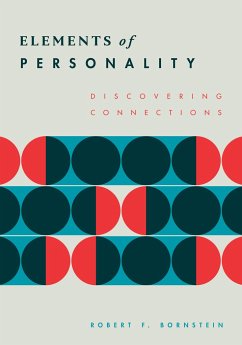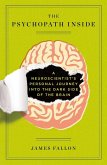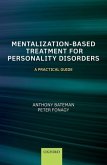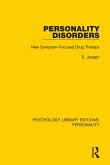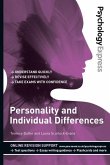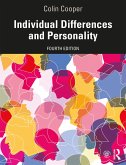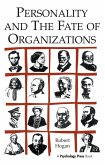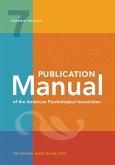- Broschiertes Buch
- Merkliste
- Auf die Merkliste
- Bewerten Bewerten
- Teilen
- Produkt teilen
- Produkterinnerung
- Produkterinnerung
A fresh, concise approach to personality theory and research for courses on personality psychology.
Andere Kunden interessierten sich auch für
![The Psychopath Inside The Psychopath Inside]() James FallonThe Psychopath Inside15,99 €
James FallonThe Psychopath Inside15,99 €![Mentalization Based Treatment for Personality Disorders Mentalization Based Treatment for Personality Disorders]() Anthony Bateman (Consultant Psychiatrist and Psychotherapist and MBMentalization Based Treatment for Personality Disorders47,99 €
Anthony Bateman (Consultant Psychiatrist and Psychotherapist and MBMentalization Based Treatment for Personality Disorders47,99 €![Personality Disorders Personality Disorders]() S. JosephPersonality Disorders57,99 €
S. JosephPersonality Disorders57,99 €![Psychology Express: Personality and Individual Differences Psychology Express: Personality and Individual Differences]() Terence ButlerPsychology Express: Personality and Individual Differences17,99 €
Terence ButlerPsychology Express: Personality and Individual Differences17,99 €![Individual Differences and Personality Individual Differences and Personality]() Colin CooperIndividual Differences and Personality70,99 €
Colin CooperIndividual Differences and Personality70,99 €![Personality and the Fate of Organizations Personality and the Fate of Organizations]() Robert HoganPersonality and the Fate of Organizations60,99 €
Robert HoganPersonality and the Fate of Organizations60,99 €![Publication Manual (Official) 7th Edition of the American Psychological Association Publication Manual (Official) 7th Edition of the American Psychological Association]() American Psychological AssociationPublication Manual (Official) 7th Edition of the American Psychological Association57,99 €
American Psychological AssociationPublication Manual (Official) 7th Edition of the American Psychological Association57,99 €-
-
-
A fresh, concise approach to personality theory and research for courses on personality psychology.
Hinweis: Dieser Artikel kann nur an eine deutsche Lieferadresse ausgeliefert werden.
Hinweis: Dieser Artikel kann nur an eine deutsche Lieferadresse ausgeliefert werden.
Produktdetails
- Produktdetails
- Verlag: American Psychological Association
- Seitenzahl: 224
- Erscheinungstermin: 16. Januar 2024
- Englisch
- Abmessung: 251mm x 174mm x 15mm
- Gewicht: 438g
- ISBN-13: 9781433838903
- ISBN-10: 1433838907
- Artikelnr.: 68541086
- Herstellerkennzeichnung
- Libri GmbH
- Europaallee 1
- 36244 Bad Hersfeld
- gpsr@libri.de
- Verlag: American Psychological Association
- Seitenzahl: 224
- Erscheinungstermin: 16. Januar 2024
- Englisch
- Abmessung: 251mm x 174mm x 15mm
- Gewicht: 438g
- ISBN-13: 9781433838903
- ISBN-10: 1433838907
- Artikelnr.: 68541086
- Herstellerkennzeichnung
- Libri GmbH
- Europaallee 1
- 36244 Bad Hersfeld
- gpsr@libri.de
Robert F. Bornstein, PhD, is a professor at the Gordon F. Derner School of Psychology at Adelphi University. He is an established researcher with national and international visibility and he has published more than 200 articles in peer-reviewed journals, along with about 60 book chapters, and written or edited more than a dozen books. Dr. Bornstein has received five federal grants from the National Institute of Mental Health and National Science Foundation. He is a fellow of the American Psychological Association, Association for Psychological Science, and Society for Personality Assessment, and served as the former president of SPA.
Preface
Acknowledgements
Chapter 1. What Is Personality?
Why Study Personality?
Four Perspectives on Personality
Culture and Personality
Personality Research Methods
Personality: Discovering Connections
Chapter Review
Critical Thinking and Discussion Questions
Key Terms
Additional Readings and Resources
Chapter 2. The Psychodynamic Perspective
Eels, Brains, Cocaine, and Hypnosis
Key Assumptions of the Psychodynamic Perspective
The Topographic Model
The Structural Model
The Psychosexual Stages
Psychoanalytic Treatment
Psychoanalysis Reimagined: Object Relations Theory
The Self-Representation and the Self–Other Dialectic
Integrating Representations of Self and Other People: Attachment Theory
Contemporary Psychoanalytic Treatments
Chapter Review
Critical Thinking and Discussion Questions
Key Terms
Additional Readings and Resources
Chapter 3. Behavioral and Cognitive-Behavioral Models
Psychology as the Behaviorist Views It
Key Assumptions of the Behavioral Perspective
Pavlov and Classical Conditioning
Skinner and Operant Conditioning
Conditioning and Personality
Conditioning and Psychopathology
Behavior Modification and the Token Economy
The Shift From Radical Behaviorism to an Integrative Behavioral Perspective
Cognitive Behavioral Treatments
Chapter Review
Critical Thinking and Discussion Questions
Key Terms
Additional Readings and Resources
Chapter 4. Trait and Interpersonal Frameworks
A Visit to Vienna and the Birth of Trait Theory
Trait Theory in Context
Key Assumptions of the Trait Perspective
Allport’s Lexical Approach
Cattell and Factor Analysis
A Consensus Emerges: The Five-Factor Model
Traits and Dynamics: The Interpersonal Perspective
Assessing Interpersonal Constructs
Interpersonal Dynamisms
Psychopathology and Psychotherapy
Chapter Review
Critical Thinking and Discussion Questions
Key Terms
Additional Readings and Resources
Chapter 5. Humanistic and Existential Approaches
Divergent Experiences, Converging Philosophies
Key Assumptions of the Humanistic Perspective
A Radical Departure
Maslow: A Hierarchy of Needs
Rogers: Self-Discrepancies
Existential Personality Theory
Existentialism Quantified: Terror Management Theory
Effects of Mortality Salience on Behavior
Chapter Review
Critical Thinking and Discussion Questions
Key Terms
Additional Readings and Resources
Chapter 6. The Future of Personality
Paradigms of Personality: Past, Present, and Future
Where Are We Now? Converging Themes
Where Are We Going? The Future of Personality
Why Are We Here?
Chapter Review
Critical Thinking and Discussion Questions
Key Terms
Additional Readings and Resources
References
Index
About the Author
Acknowledgements
Chapter 1. What Is Personality?
Why Study Personality?
Four Perspectives on Personality
Culture and Personality
Personality Research Methods
Personality: Discovering Connections
Chapter Review
Critical Thinking and Discussion Questions
Key Terms
Additional Readings and Resources
Chapter 2. The Psychodynamic Perspective
Eels, Brains, Cocaine, and Hypnosis
Key Assumptions of the Psychodynamic Perspective
The Topographic Model
The Structural Model
The Psychosexual Stages
Psychoanalytic Treatment
Psychoanalysis Reimagined: Object Relations Theory
The Self-Representation and the Self–Other Dialectic
Integrating Representations of Self and Other People: Attachment Theory
Contemporary Psychoanalytic Treatments
Chapter Review
Critical Thinking and Discussion Questions
Key Terms
Additional Readings and Resources
Chapter 3. Behavioral and Cognitive-Behavioral Models
Psychology as the Behaviorist Views It
Key Assumptions of the Behavioral Perspective
Pavlov and Classical Conditioning
Skinner and Operant Conditioning
Conditioning and Personality
Conditioning and Psychopathology
Behavior Modification and the Token Economy
The Shift From Radical Behaviorism to an Integrative Behavioral Perspective
Cognitive Behavioral Treatments
Chapter Review
Critical Thinking and Discussion Questions
Key Terms
Additional Readings and Resources
Chapter 4. Trait and Interpersonal Frameworks
A Visit to Vienna and the Birth of Trait Theory
Trait Theory in Context
Key Assumptions of the Trait Perspective
Allport’s Lexical Approach
Cattell and Factor Analysis
A Consensus Emerges: The Five-Factor Model
Traits and Dynamics: The Interpersonal Perspective
Assessing Interpersonal Constructs
Interpersonal Dynamisms
Psychopathology and Psychotherapy
Chapter Review
Critical Thinking and Discussion Questions
Key Terms
Additional Readings and Resources
Chapter 5. Humanistic and Existential Approaches
Divergent Experiences, Converging Philosophies
Key Assumptions of the Humanistic Perspective
A Radical Departure
Maslow: A Hierarchy of Needs
Rogers: Self-Discrepancies
Existential Personality Theory
Existentialism Quantified: Terror Management Theory
Effects of Mortality Salience on Behavior
Chapter Review
Critical Thinking and Discussion Questions
Key Terms
Additional Readings and Resources
Chapter 6. The Future of Personality
Paradigms of Personality: Past, Present, and Future
Where Are We Now? Converging Themes
Where Are We Going? The Future of Personality
Why Are We Here?
Chapter Review
Critical Thinking and Discussion Questions
Key Terms
Additional Readings and Resources
References
Index
About the Author
Preface
Acknowledgements
Chapter 1. What Is Personality?
Why Study Personality?
Four Perspectives on Personality
Culture and Personality
Personality Research Methods
Personality: Discovering Connections
Chapter Review
Critical Thinking and Discussion Questions
Key Terms
Additional Readings and Resources
Chapter 2. The Psychodynamic Perspective
Eels, Brains, Cocaine, and Hypnosis
Key Assumptions of the Psychodynamic Perspective
The Topographic Model
The Structural Model
The Psychosexual Stages
Psychoanalytic Treatment
Psychoanalysis Reimagined: Object Relations Theory
The Self-Representation and the Self–Other Dialectic
Integrating Representations of Self and Other People: Attachment Theory
Contemporary Psychoanalytic Treatments
Chapter Review
Critical Thinking and Discussion Questions
Key Terms
Additional Readings and Resources
Chapter 3. Behavioral and Cognitive-Behavioral Models
Psychology as the Behaviorist Views It
Key Assumptions of the Behavioral Perspective
Pavlov and Classical Conditioning
Skinner and Operant Conditioning
Conditioning and Personality
Conditioning and Psychopathology
Behavior Modification and the Token Economy
The Shift From Radical Behaviorism to an Integrative Behavioral Perspective
Cognitive Behavioral Treatments
Chapter Review
Critical Thinking and Discussion Questions
Key Terms
Additional Readings and Resources
Chapter 4. Trait and Interpersonal Frameworks
A Visit to Vienna and the Birth of Trait Theory
Trait Theory in Context
Key Assumptions of the Trait Perspective
Allport’s Lexical Approach
Cattell and Factor Analysis
A Consensus Emerges: The Five-Factor Model
Traits and Dynamics: The Interpersonal Perspective
Assessing Interpersonal Constructs
Interpersonal Dynamisms
Psychopathology and Psychotherapy
Chapter Review
Critical Thinking and Discussion Questions
Key Terms
Additional Readings and Resources
Chapter 5. Humanistic and Existential Approaches
Divergent Experiences, Converging Philosophies
Key Assumptions of the Humanistic Perspective
A Radical Departure
Maslow: A Hierarchy of Needs
Rogers: Self-Discrepancies
Existential Personality Theory
Existentialism Quantified: Terror Management Theory
Effects of Mortality Salience on Behavior
Chapter Review
Critical Thinking and Discussion Questions
Key Terms
Additional Readings and Resources
Chapter 6. The Future of Personality
Paradigms of Personality: Past, Present, and Future
Where Are We Now? Converging Themes
Where Are We Going? The Future of Personality
Why Are We Here?
Chapter Review
Critical Thinking and Discussion Questions
Key Terms
Additional Readings and Resources
References
Index
About the Author
Acknowledgements
Chapter 1. What Is Personality?
Why Study Personality?
Four Perspectives on Personality
Culture and Personality
Personality Research Methods
Personality: Discovering Connections
Chapter Review
Critical Thinking and Discussion Questions
Key Terms
Additional Readings and Resources
Chapter 2. The Psychodynamic Perspective
Eels, Brains, Cocaine, and Hypnosis
Key Assumptions of the Psychodynamic Perspective
The Topographic Model
The Structural Model
The Psychosexual Stages
Psychoanalytic Treatment
Psychoanalysis Reimagined: Object Relations Theory
The Self-Representation and the Self–Other Dialectic
Integrating Representations of Self and Other People: Attachment Theory
Contemporary Psychoanalytic Treatments
Chapter Review
Critical Thinking and Discussion Questions
Key Terms
Additional Readings and Resources
Chapter 3. Behavioral and Cognitive-Behavioral Models
Psychology as the Behaviorist Views It
Key Assumptions of the Behavioral Perspective
Pavlov and Classical Conditioning
Skinner and Operant Conditioning
Conditioning and Personality
Conditioning and Psychopathology
Behavior Modification and the Token Economy
The Shift From Radical Behaviorism to an Integrative Behavioral Perspective
Cognitive Behavioral Treatments
Chapter Review
Critical Thinking and Discussion Questions
Key Terms
Additional Readings and Resources
Chapter 4. Trait and Interpersonal Frameworks
A Visit to Vienna and the Birth of Trait Theory
Trait Theory in Context
Key Assumptions of the Trait Perspective
Allport’s Lexical Approach
Cattell and Factor Analysis
A Consensus Emerges: The Five-Factor Model
Traits and Dynamics: The Interpersonal Perspective
Assessing Interpersonal Constructs
Interpersonal Dynamisms
Psychopathology and Psychotherapy
Chapter Review
Critical Thinking and Discussion Questions
Key Terms
Additional Readings and Resources
Chapter 5. Humanistic and Existential Approaches
Divergent Experiences, Converging Philosophies
Key Assumptions of the Humanistic Perspective
A Radical Departure
Maslow: A Hierarchy of Needs
Rogers: Self-Discrepancies
Existential Personality Theory
Existentialism Quantified: Terror Management Theory
Effects of Mortality Salience on Behavior
Chapter Review
Critical Thinking and Discussion Questions
Key Terms
Additional Readings and Resources
Chapter 6. The Future of Personality
Paradigms of Personality: Past, Present, and Future
Where Are We Now? Converging Themes
Where Are We Going? The Future of Personality
Why Are We Here?
Chapter Review
Critical Thinking and Discussion Questions
Key Terms
Additional Readings and Resources
References
Index
About the Author

